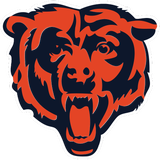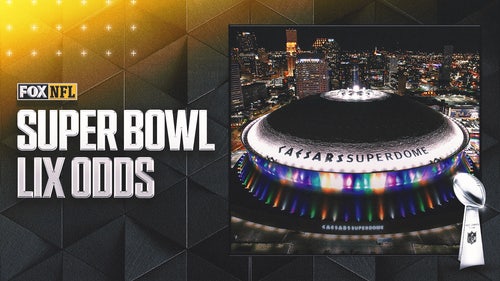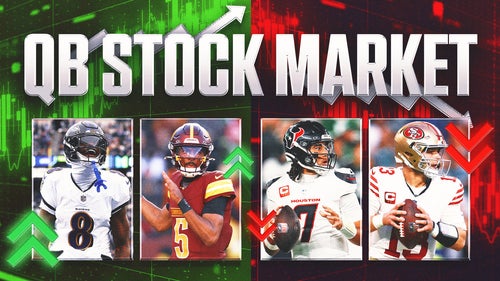
What Justin Fields' breakout means for Chicago Bears going forward
The Chicago Bears have searched high and low for a franchise quarterback since the days of Jim McMahon. Although the "punky QB" guided the Bears to a win in Super Bowl XX, he never reached the ranks of elite as a passer-playmaker.
Fast-forward to 2022 and the Bears have not only found a long-term QB1 in Justin Fields, but they might have uncovered the league's next superstar at the position. Before you @me suggesting that I am overreacting to a few electric performances from a five-star athlete with outstanding running skills and arm talent, the No. 11 overall pick in the 2021 draft is rewriting the NFL record book while displaying a set of tools that could make him a game-changer at the position.
Measuring 6-foot-2 and 228 pounds, with 4.4 speed and an extensive baseball background, Fields is the prototypical dual-threat quarterback scouts and executives will covet in the near future. The second-year pro is built like a running back but displays enough touch, velocity and range to make every throw in the book at intermediate and deep range. In addition, he can make all of the requisite throws from inside or outside of the pocket.
Although Fields' accuracy, ball placement and diagnostic skills have been concerns until recently, it is hard to find quarterbacks with five-star tools and franchise-caliber intangibles.
That's why it was so frustrating and confusing to see former Bears head coach Matt Nagy misuse Fields as a rookie. Fields was stuck in a traditional pro-style offense that confined him to the pocket instead of featuring movement passes and quarterback runs to take advantage of his electric athleticism. Watching the Bears put a square peg in a round hole reminded me of the failed experiments that have derailed other dual-threat quarterbacks attempting to make their mark in the league.
This season, new head coach Matt Eberflus and offensive coordinator Luke Getsy have unlocked Fields' immense talent by featuring more new-school concepts that have been popularized at the lower levels. From read-option plays to designed QB runs and RPOs (run-pass options) to bubble screens and jet sweeps, the Bears are teasing and tormenting their opponents with deception, misdirection and the creative utilization of an athletic quarterback.
To be fair, it took the Bears' new coaching staff six games to determine how to maximize the young quarterback after he struggled in a traditional scheme. Fields ranked near the bottom of the league in nearly every major passing statistic through six weeks. And the second-year QB's play was so inefficient and ineffective that observers were suggesting that he may be just another bust at the position.
Given some time to reassess the scheme during an extended work week following a Week 6 loss to the Washington Commanders, the coaching staff decided to implement more plays and concepts that played to Fields' strengths as a dynamic athlete. The Bears adopted some of the read-option plays and designed quarterback runs that the Baltimore Ravens feature with Lamar Jackson.
Although their running styles differ, Fields can go toe-to-toe with the former league MVP as a runner. He is not afraid to venture between the tackles, and his size-speed combination makes him tough to bring down in the open field.
Against the Miami Dolphins last Sunday, Fields set a record for the most rushing yards by an NFL quarterback in a single game (178) on an assortment of designed runs and scrambles that took advantage of his superior running skills. With the Dolphins also forced to defend running backs David Montgomery and Khalil Herbert between the tackles, the Bears' top-ranked rushing attack amassed 252 rushing yards — the team's fourth straight game with 200-plus rushing yards.
Since the Bears committed to a power-based running game with Fields as the centerpiece, the offensive production has exploded. The team is averaging 31.3 points after posting a 15.5 points per game average throughout Weeks 1-6. The Bears' No. 1-ranked rushing offense has surged to 195.4 yards per game.
"I think once you put it on tape, the guys have to defend it," Eberflus said after the Bears' 33-14 win over the Patriots in Week 7, with Fields logging 14 rushes for 82 yards. "Then you want to be creative in the ways that you do things, and you want to do it in a safe way — because it is your quarterback.
"I think it's very hard to defend," added Eberflus, a former defensive coordinator. "I've tried to defend those guys over the years, and it's very difficult."
The creativity extends to the passing game as Getsy designs complementary passing concepts to match the team's favorite runs. Play-action passes, in particular, move to the top of the call sheet with Fields utilizing ball fakes behind an offensive line showing run action to lure defenders to the line of scrimmage. With linebackers and safeties forced to respect the Bears' potent running game, the windows are bigger and wider for Fields to target at intermediate and deep range.
In addition, the clever utilization of bootlegs and movement passes simplify the reads for Fields while challenging opponents to defend the entire field. The quarterback is simply tasked with making high-low reads to one side of the field instead of executing full-field progression reads. By taking the coverage diagnosis out of the read and making it a game of "pickle" on a designated defender, the Bears have helped Fields become more efficient and effective as a passer.
The Bears have also helped their young quarterback by adding size and length to the wide receiver room. The acquisitions of N'Keal Harry (6-foot-4, 225 pounds) and Chase Claypool (6-foot-4, 238 pounds) have given Fields a pair of extra-large targets with the capacity to expand his strike zone due to their length and leaping ability. The super-sized pass-catchers will not only excel on the bootlegs and crossing routes that routinely accompany bootlegs and play passes, but they should become factors in the red zone on 50-50 balls (fades and slants).
Considering how Harry and Claypool will also contribute as punishing blockers on the edges due to their superior size and strength, the Bears are revamping their roster to reflect their shift in offensive philosophy. The team will need to continue to make moves to fully maximize Fields' talents and the offense's potential utilizing an unconventional approach.
According to OverTheCap.com, the Bears will have more than $123 million of projected cap space entering next season, by far the most in the NFL. GM Ryan Poles should follow the Ravens' blueprint and prioritize adding "bigs," surrounding Fields with enough "people movers" to run the ball against any front. With the right offensive linemen and tight ends on the roster, the Bears can exploit mismatches (Fields' speed against extra linemen and linebackers) while bullying opponents unable to deal with the team's run-heavy sets.
The Bears would also be wise to invest in a backup athletic quarterback to enable the team to fully commit to an option-based attack that features the QB as a runner. As the Ravens have done with Tyler Huntley serving as the QB2 behind Jackson, the Bears should be able to identify a few developmental prospects in the 2023 draft to ensure enough QB depth in case Fields takes a little beating as a runner.
"I think we are building our football team," Eberflus said on the team website. "We have a young football team. We are building upon that. And the centerpiece of that is the quarterback. That's the way it is in the NFL.
"Talk about toughness and grit and the ability to persevere through a lot of different things," Eberflus added regarding Fields. "Obviously, start of the season is feeling his way, and now the last three games he's really taken off. And we are excited about that as a group, and we are excited about that for the Chicago Bears and the franchise."
Bucky Brooks is an NFL analyst for FOX Sports. He regularly appears on "Speak For Yourself" and also breaks down the game for NFL Network and as a cohost of the "Moving the Sticks" podcast. Follow him on Twitter @BuckyBrooks.










